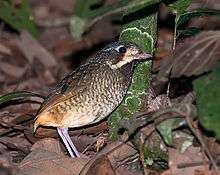Variegated antpitta
The variegated antpitta (Grallaria varia) is a species of bird in the family Grallariidae. It is found in southeastern Brazil, eastern Paraguay, the Guianas and the northern Amazon Basin. Its range extends to Venezuela in the northwest; in the Amazon Basin, it is found in the downstream half of the basin, as well as in the Atlantic outlet region of the neighboring Tocantins-Araguaia River drainage to the southeast. A minor disjunct population is in Peru, and an Argentinian population is found in the tongue of land between Paraguay and southern Brazil.
| Variegated antpitta | |
|---|---|
 | |
| Scientific classification | |
| Kingdom: | Animalia |
| Phylum: | Chordata |
| Class: | Aves |
| Order: | Passeriformes |
| Family: | Grallariidae |
| Genus: | Grallaria |
| Species: | G. varia |
| Binomial name | |
| Grallaria varia (Boddaert, 1783) | |
Its natural habitats are subtropical or tropical moist lowland forest and subtropical or tropical moist montane forest.
Taxonomy
The variegated antpitta was described by the French polymath Georges-Louis Leclerc, Comte de Buffon in 1780 in his Histoire Naturelle des Oiseaux from a speciment collected in Cayenne, French Guiana.[2] The bird was also illustrated in a hand-coloured plate engraved by François-Nicolas Martinet in the Planches Enluminées D'Histoire Naturelle which was produced under the supervision of Edme-Louis Daubenton to accompany Buffon's text.[3] Neither the plate caption nor Buffon's description included a scientific name but in 1783 the Dutch naturalist Pieter Boddaert coined the binomial name Formicarius varius in his catalogue of the Planches Enluminées.[4] The variegated antpitta is now placed in the genus Grallaria that was introduced by the French ornithologist Louis Jean Pierre Vieillot in 1816.[5][6] The genus name is from New Latin grallarius meaning "stilt-walker". The specific epithet varia is from Latin varius meaning "various", "diverse" or "variegated".[7]
Five subspecies are recognised:[6]
- G. v. cinereiceps Hellmayr, 1903 – south Venezuela, northwest Brazil and northeast Peru
- G. v. varia (Boddaert, 1783) – east Venezuela, the Guianas and northeast Brazil
- G. v. distincta Todd, 1927 – central Brazil
- G. v. intercedens von Berlepsch & Leverkühn, 1890 – east Brazil
- G. v. imperator Lafresnaye, 1842 – southeast Brazil, east Paraguay and northeast Argentina
References
- BirdLife International (2012). "Grallaria varia". IUCN Red List of Threatened Species. 2012. Retrieved 26 November 2013.CS1 maint: ref=harv (link)
- Buffon, Georges-Louis Leclerc de (1780). "Le roi des fourmiliers". Histoire Naturelle des Oiseaux (in French). Volume 8. Paris: De L'Imprimerie Royale. pp. 231–233.
- Buffon, Georges-Louis Leclerc de; Martinet, François-Nicolas; Daubenton, Edme-Louis; Daubenton, Louis-Jean-Marie (1765–1783). "Le roi des fourmilliers, de Cayenne". Planches Enluminées D'Histoire Naturelle. Volume 8. Paris: De L'Imprimerie Royale. Plate 702.
- Boddaert, Pieter (1783). Table des planches enluminéez d'histoire naturelle de M. D'Aubenton : avec les denominations de M.M. de Buffon, Brisson, Edwards, Linnaeus et Latham, precedé d'une notice des principaux ouvrages zoologiques enluminés (in French). Utrecht. p. 44, Number 702.
- Vieillot, Louis Jean Pierre (1816). Analyse d'une Nouvelle Ornithologie Elementaire (in French). Paris: Deterville/self. p. 43.
- Gill, Frank; Donsker, David, eds. (2019). "Antthrushes, antpittas, gnateaters, tapaculos & crescentchests". World Bird List Version 9.1. International Ornithologists' Union. Retrieved 14 August 2019.
- Jobling, James A. (2010). The Helm Dictionary of Scientific Bird Names. London: Christopher Helm. pp. 177, 398. ISBN 978-1-4081-2501-4.
External links
- Xeno-canto: audio recordings of the variegated antpitta
- Variegated antpitta photo gallery VIREO Photo-High Res
- Photo-High Res; Article fieldmuseum.org–"Rapid Biological Inventories"
- Graphic-Medium Res & Article www.sib.gov.ar/fichas/fauna
